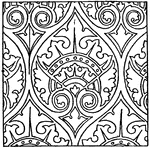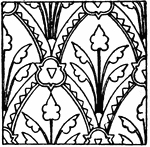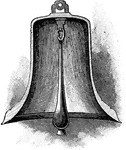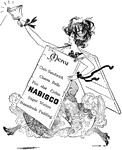
Lincoln Cathedral
The Lincoln Cathedral in England is an example of early English Gothic architecture during medieval…
Tower of Santa Maria in Cosmedin
"Tower of the Early Christian Basilica of S. Maria in Cosmedin at Rome." Santa Maria in Cosmedin (or…
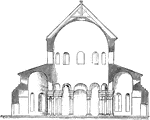
Santa Costanza
"Section of the Church of S. Constantia at Rome. The simplest desctiptions of this kind of building…

Dome System of Hagia Sophia
"Dome-System of the Church of Sta. Sophia at Constantinople. The Byzantine style of this first period…

Section of Hagia Sophia
"Section of the Church of Sta. Sophia at Constantinople. The Byzantine style of this first period reached…
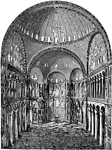
Interior of Hagia Sophia
"Interior of the Church of Sta. Sophia at Constantinople. Besides the Narthex, there was a second vestibule:…

Exterior of Hagia Sophia
"Exterior of the Church of Sta. Sophia at Constantinople. Although the impression conveyed by this church…

Comfrey
Comfrey (also comphrey) is an important herb in organic gardening, having many medicinal and fertilizer…

Comfrey Flower
Comfrey (also comphrey) is an important herb in organic gardening, having many medicinal and fertilizer…

Comfrey (Longitudinal Section)
Comfrey (also comphrey) is an important herb in organic gardening, having many medicinal and fertilizer…

Sepal and Fruit of Comfrey
Comfrey (also comphrey) is an important herb in organic gardening, having many medicinal and fertilizer…

Encaustic Tile
"Encaustic tile, a tile for pavement- and wall-decoration, in which the pattern is inlaid or incrusted…

Westminster Abbey
An illustration of the Poet's Corner in Westminster Abbey. The Collegiate Church of St Peter at Westminster,…

Bell Heather
The magnified flower of the Bell Heather (Erica cinerea) is a plant in the Ericaceae family of heaths.
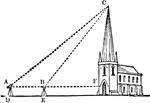
Triangle with Church
An illustration of a triangle comprised of a church and two lines. This illustration can be used to…

Monkwearmouth Church
Monkwearmouth is an area of Sunderland located at the north side of the mouth of the River Wear. It…
Renaissance Oblong Panel
The Renaissance Oblong Panel is found at a church in Kamenz, Germany. It has a freer decoration of palmettes.

Renaissance Oblong Panel
This Renaissance Oblong Panel is a design found on Marsuppini's tomb in the St. Croce church of Florence,…
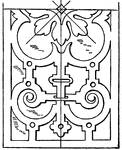
Renaissance Oblong Panel
This Renaissance Oblong Panel is a design found at the St. Michaels' church in Germany.

Renaissance Lunette Panel
This Renaissance lunette panel is an intarsia (wood inlay) design. It is found in the Santa Maria church…
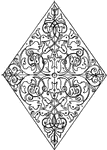
Door Lozenge Panel
The door lozenge panel is a rhombus shape. It is a 17th century design found in the Nordlingen church…
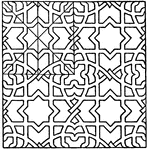
Geometrical Pattern
This geometrical circle pattern found in the St. Croce church in Florence, Italy.

Marble Mosaic Circle Pattern
The marble mosaic circle pattern is inlaid pieces of stone, wood, glass, leather or straw to make a…
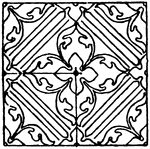
Painting Pattern
The painting pattern is an Italian Renaissance design, found in the Santa Croce church in Florence,…
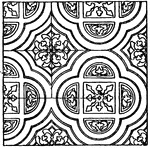
Painting Pattern
The painting pattern is a 13th century design found in the consistory (governing body) church in Assisi,…
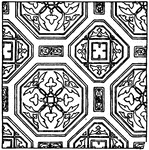
Painting Pattern
The painting pattern is a 13th century design found in the consistory (governing body) church in Assisi,…
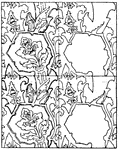
Gold Pattern
This gold pattern is a design found on the floor of the altar shrine in the church of St. Egidius, Barthfeld,…
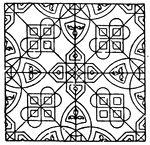
Bishop's Robe Pattern
This Bishop's robe pattern is found in the sacristy of the St. Croce church in Florence, Italy. It is…
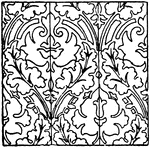
Painted Gold Pattern
This painted gold pattern is 15th century design found on the floor of the St. Lorenzo church in Rottweil,…
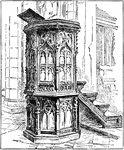
Pulpit
A pulpit (from Latin pulpitum "scaffold", "platform", "stage") is a small elevated platform from which…

Tone
"A glass bell is fixed to stand, and beside it is a stand carrying a small ivory ball. This is so arranged…

Sir Thomas More
Sir Thomas More (7 February 1478 – 6 July 1535) was an English lawyer, author, and statesman who…

Thomas Cranmer
Thomas Cranmer (2 July 1489 – 21 March 1556) was a leader of the English Reformation and Archbishop…

Fava Bean
The fava bean plant (Vicia faba or Faba vulgaris) is a flowering plant in the Fabaceae family of legumes.
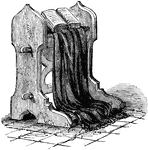
Faldstool
"A small desk in cathedrals, churches, etc., at which the litany is enjoined to be sung or said. It…
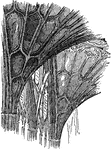
Fan-Tracery of Cloisters of Gloucester Cathedral
The cloisters of Gloucester Cathedral in England show an early example of fan-tracery, patterns carved…

Fenestella in the Church of Norrey
"Fenestella. In Roman Catholic churches, a niche on the south side of an altar, containing the piscina,…
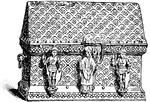
Feretory
"Feretory. English medieval silverwork. A shrine or bier containing the relics of saints, adapted to…

Apse of a Cathedral
An illustration depicting the inside of an apse. In architecture, the apse (Latin absis "arch, vault";…

Tracery Foliations
The tracery on the windows of La Sainte-Chapelle, in Paris, France shows foliations: a leaf pattern…

Baptismal Font
"Font, Cathedral of Langres, France; end of 13th century. A repository for the water used in baptism;…

Gable at Notre Dame de Paris
"Gable of the South Transept Door of Notre Dame, Paris; 13th century." -Whitney, 1911

Gable Tower in France
"Gable Tower, Dormans, France. A tower finished with gables on two sides or on all four sides, instead…

Galleries of Cathedral of Amiens
"Galleries of the west front of the Cathedral of Amiens, 13th century, illustrating treatment of galleries…
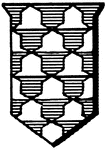
Vair Shield Fur
A shield or escutcheon emblazoned with the fur, vair, represented by alternating azure (blue) and argent…
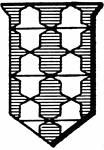
Counter-Vair Shield Fur
A shield or escutcheon emblazoned with the fur, vair, represented by alternating azure (blue) and argent…
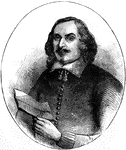
Edward Winslow
Edward Winslow (1595 – 1655) was an American Pilgrim leader on the Mayflower. He served as the governor…



